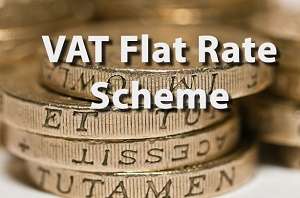FLAT RATE SCHEME: All VAT registered businesses report the amount of VAT paid on purchases and the amount charged to customers.
The difference in these amounts will either get paid to, or claimed from, HM Revenue and Customs. But, the VAT Flat Rate Scheme is different:
- Payments to HMRC will be at a fixed rate of VAT.
- The company retains the difference between the VAT amount charged to customers and the amount payable to HMRC.
- The business cannot reclaim the VAT on purchases (except for certain capital assets over £2,000).
VAT turnover must be £150,000 or less, excluding VAT, for a company to join the scheme. All applications must be made to HM Revenue and Customs.
Note: Consult an accountant or tax adviser to find out if the Flat Rate VAT Scheme is right for your business.
How to Join or Leave the Scheme
Joining the Scheme
You must check your company’s eligibility before you apply to join. As a rule, joining the scheme takes place:
- When you register for VAT online.
- By postal methods using the form ‘VAT600FRS‘ sent to the address written on the form.
- When applying for the Annual Accounting Scheme using the form ‘VAT600AA/FRS‘ (e.g. by emailing it to [email protected]).
HMRC will confirm that your application got accepted by post – if you did not apply online. Otherwise you will see the confirmation in your VAT online account.
Leaving the Scheme
 If a company is no longer eligible they must leave the scheme. A business can leave the scheme at any time if they believe it is no longer beneficial for them.
If a company is no longer eligible they must leave the scheme. A business can leave the scheme at any time if they believe it is no longer beneficial for them.
HM Revenue and Customs
Imperial House
77 Victoria Street
Grimsby
Lincolnshire DN31 1DB
Write to HMRC telling them the company is leaving the scheme. They will then confirm a leaving date for you. If the company wants to rejoin the scheme, they must wait twelve (12) months after the leaving date.
Flat Rate VAT Scheme Eligibility Criteria
To join the Flat Rate Scheme the company must be a VAT-registered business. The company’s expected taxable turnover, excluding VAT, must also be £150,000 or less in the next year.
Note: The VAT taxable turnover relates to all goods and services sold – that are not tax exempt.
VAT Flat Rate Scheme Exceptions
A business will not qualify for the scheme if:
- They left the scheme in the previous twelve months.
- It committed a tax offence in the last twelve months (such as tax evasion).
- It has joined, or are eligible to join, a VAT group in the last two years.
- It registered as a VAT business division in the last two (2) years.
- The business has close associations with another business.
- It joins a capital goods or margin VAT scheme.
A company cannot use the Cash Accounting Scheme with the VAT Flat Rate Scheme. Instead, it uses its own cash-based method to calculate the turnover in the Flat Rate Scheme. See ‘section 9 of the VAT Notice 733’.
When You Must Leave the Scheme
All businesses must leave the scheme any time:
- They no longer meet the eligibility criteria for staying in it.
- In the first year in the scheme the company’s total income, including VAT, is more than £230,000.
- The company expects their income in the next twelve months to exceed £230,000.
- The expected total income will exceed £230,000 in the next month alone.
Note: Check the process for working out the flat rate scheme percentages 2022. There are periodic changes so you must use the most current proportions.

